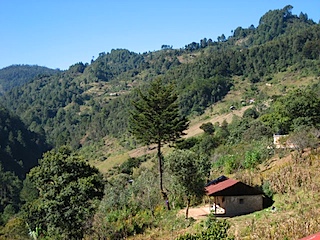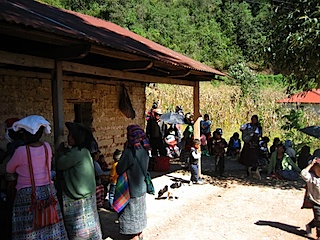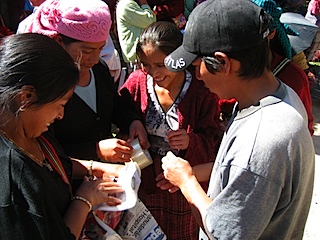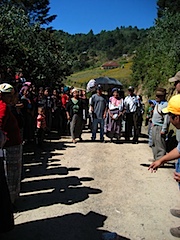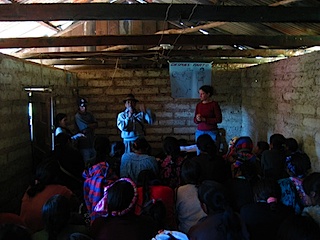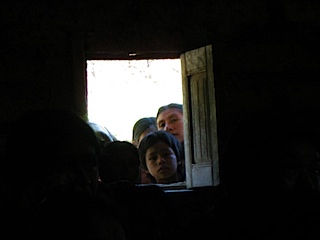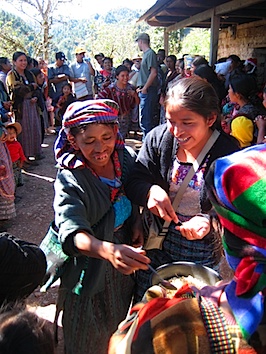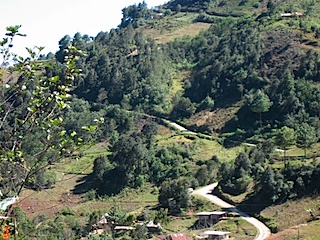 Yesterday we got to visit a new village: Nancultac. It is about ten minutes from the market town; or rather, it should be. Yesterday, however, it was about 45 minutes away because there were no microbusses and we had to walk this scenic road in the picture to the right. This was inconventient, because we were going there to give a half-day workshop on maternal mortality, and we were therefore about an hour late. Luckily, this is Guatemala, and no one batted an eye. When we arrived, the villagers were all sitting patiently, waiting for us in front of the adobe hut they use as a meeting space.
Yesterday we got to visit a new village: Nancultac. It is about ten minutes from the market town; or rather, it should be. Yesterday, however, it was about 45 minutes away because there were no microbusses and we had to walk this scenic road in the picture to the right. This was inconventient, because we were going there to give a half-day workshop on maternal mortality, and we were therefore about an hour late. Luckily, this is Guatemala, and no one batted an eye. When we arrived, the villagers were all sitting patiently, waiting for us in front of the adobe hut they use as a meeting space.
A few months back, we gave a brief talk on the impact of maternal mortality at a county-wide leaders’ meeting, and apparently it got some attention, because the elders of Nanclutac asked Aurelio (our counterpart) if he could convince us to come talk in depth about the subject. We agreed instantly, because this is a great chance to increase our exposure and work with a new group of people. And seeing more beautiful countryside never hurts, either.
Aurelio originally guessed that we’d have an audience of about 50, but it turned out we had more than a hundred. So many, in fact, that there was no way they would all fit into the hut. So, the overflow just sat outside. Everyone here loves to use a bullhorn to speak, even in a tiny room, and we normally don’t use it. This time, however, we had to so that the people outside could hear what was going on inside.
Part of our teaching technique is to use participative learning, breaking up classroom-style lectures with “dynamicas”, or games. I looked around the cramped room and realized that our opening icebreaker game would have to happen outside. I mentioned it to the leader.
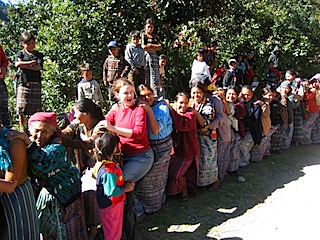 “Yeah, you can do the dynamica to the east of the building, on the road, while we’re doing our dynamica on the other side of the building,” he replied. He then started herding everyone out of the hut.
“Yeah, you can do the dynamica to the east of the building, on the road, while we’re doing our dynamica on the other side of the building,” he replied. He then started herding everyone out of the hut.
This confused me, as did his insistence that I take all my personal effects with me when I left. But lots of things here confuse me, so I just played along and followed the horde of women up the hillside to the road, the only flat place around for miles. After the hubbub died down, we got to business. Here we see Emily in a big, tight circle of Mayan women showing them that if they all work together and sit down at the same time, no one falls. Go Teamwork!
A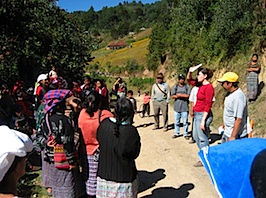 fter the dynamica, we started the first of the three lectures, this one on what a high-risk pregnancy is. This is important stuff to know in a culture where 98% of births happen at home in a mud hut attended by an illiterate midwife. Sadly, our municipality has the highest rate of death during childbirth in all of Guatemala. The sun was POUNDING down on us as we talked; the villages around here are all at about 9,000 feet above sea level, and there’s not a lot of atmosphere left up there to cut down the UV. A few minutes into the lecture, a nice little lady got up and gave us her parasol. That’s how people are here.
fter the dynamica, we started the first of the three lectures, this one on what a high-risk pregnancy is. This is important stuff to know in a culture where 98% of births happen at home in a mud hut attended by an illiterate midwife. Sadly, our municipality has the highest rate of death during childbirth in all of Guatemala. The sun was POUNDING down on us as we talked; the villages around here are all at about 9,000 feet above sea level, and there’s not a lot of atmosphere left up there to cut down the UV. A few minutes into the lecture, a nice little lady got up and gave us her parasol. That’s how people are here.
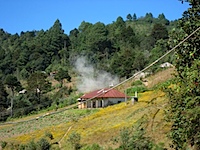 Toward the end of the lecture, we were interrupted by a giant explosion. Everyone looked over towards the hut we had just been in, and then there was a second explosion that threw bowling ball-sized rocks a hundred feet in the air. Oh! They weren’t doing a dynamica on the other side of the meeting hut, they were using dynamite!!!!! Silly me. Pay attention in Spanish class, boys and girls, or you might wind up on the wrong end of something bad, be it explosives or just common fleas.
Toward the end of the lecture, we were interrupted by a giant explosion. Everyone looked over towards the hut we had just been in, and then there was a second explosion that threw bowling ball-sized rocks a hundred feet in the air. Oh! They weren’t doing a dynamica on the other side of the meeting hut, they were using dynamite!!!!! Silly me. Pay attention in Spanish class, boys and girls, or you might wind up on the wrong end of something bad, be it explosives or just common fleas.
After we finished the first lecture, we eased into the second dynamica. I rounded up three volunteers, and had them pick four assistants to help them. Then I handed each team a roll of tape and a bunch of old newspapers. “What is this?” I asked, holding up an egg. They laughed at my silly question. “Your task is to wrap an egg in paper and tape in such a way as to protect it from a fall.”
I gave them five minutes to wrap their eggs, then got everyone’s attention again, holding up another egg. “So, who knows what will happen if I toss this one over by Aurelio?
“It will break!” someone yelled. So I tried it, and they were right. It did! They all laughed.
“So, what will happen if they throw their protected eggs?” I asked, pointing to my three volunteers.
“¿Saber?” someone said. (Who knows?) So, we tried it. Here we see Mayans throwing padded eggs; click on the second one to check out the egg in midair! When everyone had gone, we cut the packages open and saw that one egg was whole, one was cracked, and one was totally destroyed. We didn’t even plan that..heh.
We then discussed how eggs are fragile, like human life. The more layers of protection we set up, the more likely they are to survive a mishap. The same is true for childbirth; the more we prepare, and understand, and protect, the more chance these mothers will have of surviving.
About that time, we got the all-clear to return to the hut. Once everyone got settled, we continued talking about how to prepare a house for a childbirth, and the personal preparations you need to make beforehand. The room was still super crowded, and people kept peeking in the window to get a better view. Then came time for the final dynamica: the corn relay.
This is my favorite one. I ask for three volunteers, and they get to be “mothers”. They then draw cards with numbers: 3, 5, and 10. They then have to search the crowd for that number of people to act as kids in their family. Then, I give each mother a spoon.
Across the yard, I get a volunteer to hold a basket of dried corn kernels: the universal Mayan symbol of food. “When I say go, you have thirty seconds to bring back corn to distribute amongst your children in any way yo see fit. You may only carry it with your spoon.” Everyone sees the hilarity coming, and they’re laughing before I even start the race.
After thirty seconds of scrambling, I stop the chaos and we we look at what’s happened. I explain to the crowd that kids with more than 30 kernels are strong, healthy, and well-fed. They succeed in school and play in the yard. Usually, the mom with three kids does fine, and sometimes the one with five does too.
However, kids with less than 30 kernels are undernourished, and have trouble learning and working and playing. They get sick more often. But the saddest part is that there are usually a few kids with NO corn. In this game, that means that they starved to death. And the mother with 10 kids ususally has a few in this category.
Back in the hut, we talk about what happened. The women realize pretty readily that the mother with less children had an easier job. “What about the mother of ten? Was she lazy?” I ask. No, of course not, she ran like crazy. They all could see that. “But some of her children died anyways.” A pause, some murmuring. “Do you think their death was her fault? Was she a bad mother?” This strikes home with a lot of them who have spent much of their lives struggling to feed and clothe their own 9, 10, 11, or 12 children. Of course she wasn’t a bad mother, but it didn’t have to happen this way.
This is the lead-in to our last talk of the day, about Family Planning: what it is, and why it’s important, and how it can even save a mother’s life. In this case, Emily talks about how nowadays in Guatemala, families have the right and means to decide how many kids they want and when they will have them. Sometimes, having less means more resources to go around. Having them later means that young parents can finish school and get better jobs (and maybe build their own house to live in). Spacing them out to more than a year between kids means that women can recover better between childbirths, increasing their chance of survival. Family Planning brings a host of benefits that we as Americans often take for granted, and many Mayans have never even heard of it.
In all, we feel like our workshop in Nancultac went well. After we finished, people milled out to return to their daily lives. It’s hard to really know if you reach people or not, but as I was telling Emily… the talk she gave today might save a life at some point down the road, and we will never know. We were standing outside the hut discussing it, when two of the village leaders respectfully interrupted to let us know that they’d called a car to come take us back… and they were going to take us to lunch in town. Because that’s how people are here.
